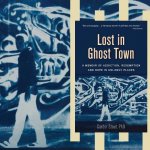
Pacifica Alumni/ae Shine at ASWM 2020 National Conference
Eight Pacifica Graduate Institute alumni/alumnae will be presenting at the Association for the Study of Women and Myth’s 2020 National Conference in Albuquerque, March 13 and 14. The following are the presenters along with abstracts from their presentations.
Susan Chaney (2015 PhD Mythological Studies)
Conscious Awakening: Particles in the Cosmos
Ralph Waldo Emmerson in his essay “The Over-Soul” describes our conscious reality as where, “We live in succession, in division, in parts, in particles.” If we believe the unified field theory where, those particles that we comprise are subatomic particles that have nuclear, electromagnetic, and gravitational forces, that unify us to the whole of the cosmos, then its possible to trigger our inherent potential and have the capacity to merely focus our conscious attention to reach our most profound states of being. Through our focused attention to what we are conscious of in our environment, we can bring what is unconscious into conscious awareness in action. Our memories are our conscious record of experiences. Often as time passes the memory of the experience changes and specifics are edited, because that is the nature of memory as time passes, however, the staccato or the element that made it a conscious memory remains the same. Is that why our memory is always changing? Perhaps what remains in terms of our emotions and visceral attachments are the pathways to look beyond the veil into what is asking to come into consciousness. Is this the nature of mythology, those stories of cultures that are believed, but may not be true? What arises out of myths are castellated events that are way markers to achieve consciousness. They are the stories that tell us how to avoid the pitfalls and expand our individual conscious awareness so that we can awaken unity consciousness with each other, where as particles in division we unite.
Cheryl De Ciantis (2005 PhD Mythological Studies)
Recovering the Embodied Mythos of the Makers and its Significance for Ethical Technology
A mythopoetic “biography” of Hephaistos, the Greek god of Making, tells us why we view technology the way we do; why Western culture both reveres and fears technology and pathologizes creativity and imagination; and why we fail to perceive the urgent need to claim our own creativity and insist that all our technological strivings must be fundamentally grounded in a life-centered ethics. This mythic biography can be reconstructed from ancient texts and images in Greek as well as African, East Asian, Nordic and other traditions. We have forgotten that Making is grounded in physical embodiment, and intended for creating good conditions for life on Earth. Hephaistos alone among the Olympian pantheon is a wounded god, who Homer tells us has felt “human pain.” One additional figure is so described by Homer: Thetis, beloved fostermother of Hephaistos and a member of the primordial, divine lineage of Ocean. Both of these mythic figures tell us about the divine nature of physical embodiment as the core of the archetype of Making. Further, the Feminine was anciently revered as the source of the instrumental and collaborative skills of Making; but its power has long since been fragmented along with the stories that trace it. Patriarchal voices since before Plato have controlled the mythic narratives of technology and arts and their significance to the community at large. The wisdom we need to reconstruct an inclusive, grounded mythos of technology that speaks to the needs of our planet now is in the myths and always was.
Jaffa V. Frank (2017 PhD Mythological Studies)
Loving Medusa. Redeeming Athene: Re-storying Female Blood, Sovereignty, and Agency
By dialoguing with mythic material through the experiencing body, creative imagination, and narrating mind we weave stories of female empowerment that embrace the sacredness of all of life, as it is, including the truths of death and regeneration echoed in menstrual blood. The Great Goddesses once signified this unified multiplicity and the Gorgon Medusa is one face of the often vilified, sometimes rageful, multivalent visage of unmitigated feminine potency. Her paradoxical masks range from beautiful victim to apotropaic protector to emblem of the Evil Eye, menstrual taboos, and embodied misogyny. In her lineage and at her core, the Gorgon carries the blood of life, death, and renewal; the mysterious sacred tremendum. Famously, Athene—Father’s Daughter who disavows her maternal lineage and proclaims that she is “always for the male”—is instrumental in both creating and beheading the Gorgon, and redeeming mankind from the petrifying menace. But perhaps it is Medusa who redeems Athene, restoring the goddess from the split engendered in her adaptation to the phallocentric demands of one-sided patriarchy; an adaptation demanded of every daughter of the patriarchy. By deeply engaging the interwoven myths of the Gorgon and Athene, new stories of female agency and sovereignty emerge and the profoundly sacred nature of every-woman’s Medusan body is reclaimed with a critical piece of instruction, so easily missed: She must be held at the level of the heart, in the field of transpersonal love to be reborn from the heart, fully intact; the virgin birth.
Dan Gurska (2017 PhD Mythological Studies)
Deluge Myths to Live By?
In The Goddess, Dr. Christine Downing shares that “We need images and myths through which we can see who we are and what we might become.” This paper and presentation is a modest attempt to appropriately appropriate various world myths of inundation, catharsis, and renewal to better see who we are and what might become of us. What can we learn from Sekhmet, Atrahasis, Matsya, and Noah as our world literally drowns? What do the great flood myths of the world have to say about humankind’s relationship to nature? What might we make from our catastrophic climate emergency?
Hannah Irish (2018 MA Mythological Studies)
A Midrashic Look at Queen Michal: The Tragic Lover-Hero of the Davidic Narrative
Though the scholarly tradition has painted her in a mostly negative light, I argue that Michal, the daughter of King Saul and the first wife of King David, is a biblical character who can, and should, be viewed as a heroine in her own right. Scholars, in both the Jewish and Christian traditions, have overwhelmingly characterized Michal as either a villain or a victim, in stark contrast to her husband, King David. However, these interpretations do not do her justice, nor are they faithful interpretations of the biblical texts themselves. While the major events in her life were orchestrated by the men in power, the two most detailed and significant episodes of her story were instigated by herself, and were acts of courage and conviction despite great risk, both personal and political. In a mythology dominated by men, and in which women are often demonized, abused, and used as pawns, it is imperative to identify and re-claim the stories of these women in ways that inspire women today. Re-painting Michal as a woman of agency, courage, strength, conviction, dignity, and integrity is crucial to provide girls and young women with powerful figures to learn from in the biblical tradition.
Ann Maxwell (2008 PhD Mythological Studies)
What We Make Is Where We Are: Place, Art, and Transformation
Place is in the Psyche and manifests through our embodiment and creative expression. As imaginal beings we collect images of the landscape and specific physical surroundings made indelible by culturally subjective experiences, located mythological traditions of the people with whom we share place, along with the wealth of our imaginations. Because what we make is so wholly influenced by where we are, the history between place and making (craft and art) is complex. From the Enlightenment onward being emplaced has born the burden of contradictory values. While certain positive characteristics are attributed to longevity in place, the local or being located has also been denigrated. This conflicted attitude toward locale (city vs. rural; close vs. far) along with a bias lowering craft to utilitarian while elevating art, often diminished the results of those whose purpose and work was significantly emplaced. Challenges to the separation of art and craft by women artists in the later 20th Century has resulted in broader, more inclusive definitions of art for everyone. Along with this expansion of the definition of art, came a surprising resurgence of interest in the subject of place by scholars in multiple fields. Place, similar to myth is paradoxical and handles the tension between the universal and the particular while depending upon both. This paper examines the intersection of place’s resurgence and art’s transformation through women’s art and ways in which each has transformed the other.
Margaret Mendenhall (2018 PhD Mythological Studies)
“The Perfect Mate”: Integration of the Animus into the Psyche or a Patriarchal Ideal of Femininity?
The episode from Star Trek: Then Next Generation that has resonated with me the most for over twenty-five years is “The Perfect Mate.” In it, Famke Janssen portrays a beautiful female alien who is secretly brought aboard the Enterprise in an egg-like container. The only one of her kind born in a generation, once she bonds with a mate she is able to sense and fulfill his every desire. Since childhood she has been raised to fulfill her destiny of being offered to the leader of a warring planet as a gift to seal a peace agreement. Once she is discovered aboard the Enterprise, her presence arouses not only the passions of the males but the ire of the female officers who see her as being treated like a sex slave. Captain Picard is forced by them, and his own conscience, to investigate. Although he controls his desire for her, she bonds to him and turns into a woman that would be his ideal; which of course means that she will still fulfill her obligations to her planet. I will analyze this episode from a mythological and depth psychological perspective to ask whether this an elucidation of the integration of the animus, the male other inside the female psyche, or is it a portrayal of a patriarchal ideal of femininity, to be beautiful, brave, independent, yet obedient to the laws of men?
Stephanie Zajchowski (2019 PhD Mythological Studies)
Apocalyptic Gender Coding: The Influence of the Myth of the Whore of Babylon on Gender in the United States
The Whore of Babylon is a diabolical figure in the Book of Revelation, the final book of the canonical Bible that tells of the end of the world. Throughout history, this image has been used metaphorically to communicate a threat. The focus on the Whore as a woman and mother infuses the female body with apocalyptic significance and reinforces patriarchal gender roles. This presentation traces an American mythology of the Whore of Babylon and examines its influence on cultural ideas about gender in the United States. While multiple mythemes emerge from these various iterations of the religious image, focusing on the mytheme of Empire and Decadence allows the presentation to enter into ongoing postcolonial, womanist, and feminist critiques of Revelation’s liberation narrative. Further, the study asserts that the myth of the Whore of Babylon is important to meaning- making in contemporary American reproductive dialogues. A feminist critique exposes how the appearance of this mytheme in anti-abortion discourse influences cultural ideas about gender, sexuality, and reproduction, manifesting in public policies that police female reproduction. Building on the long history of retelling the myth of the Whore of Babylon to inspire liberation, this presentation concludes with an alternate reading of the Whore myth that works to reclaim the female power in the narrative. By holding the complex fluidity of this mythic image as both oppressive and liberating for women, we may imagine beyond the social limitations of gender, particularly as it relates to the procreative body.
For more information about the event, please go to: womenandmyth.org/events/




